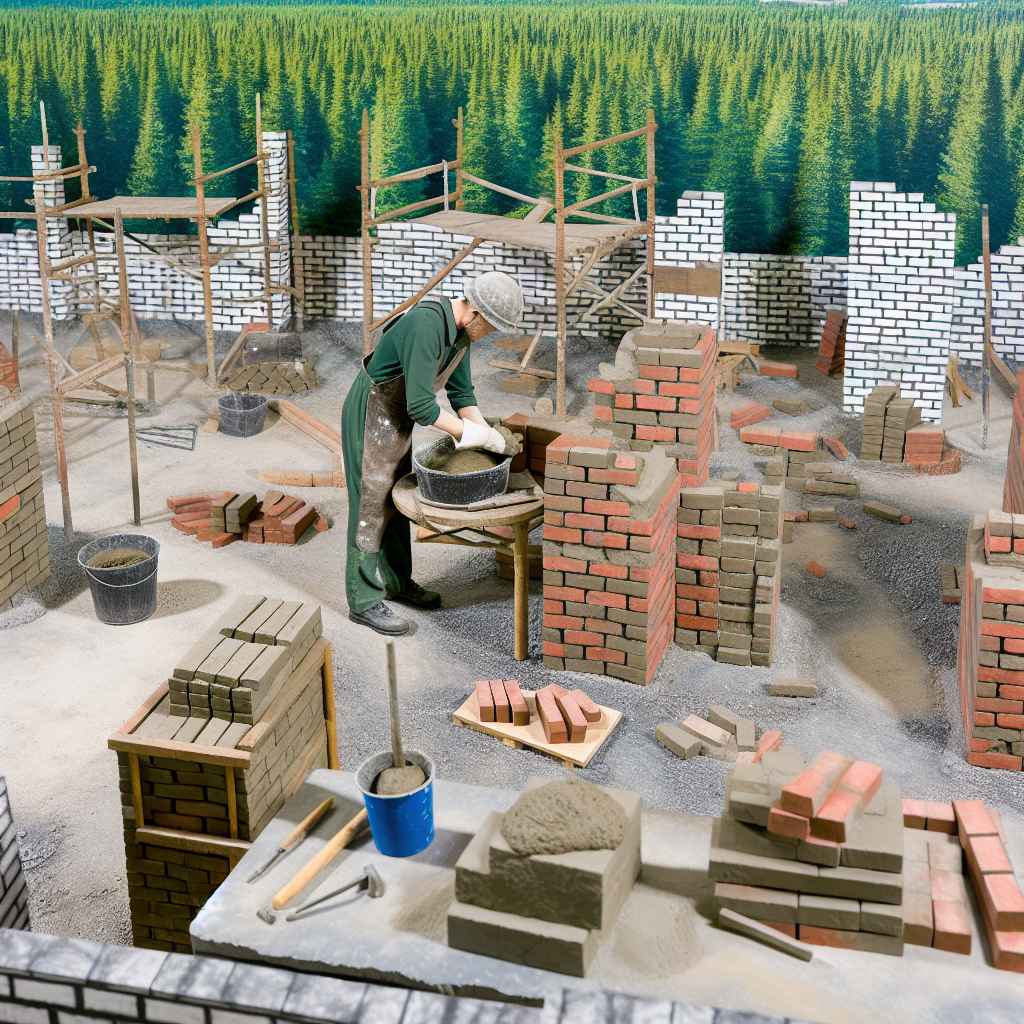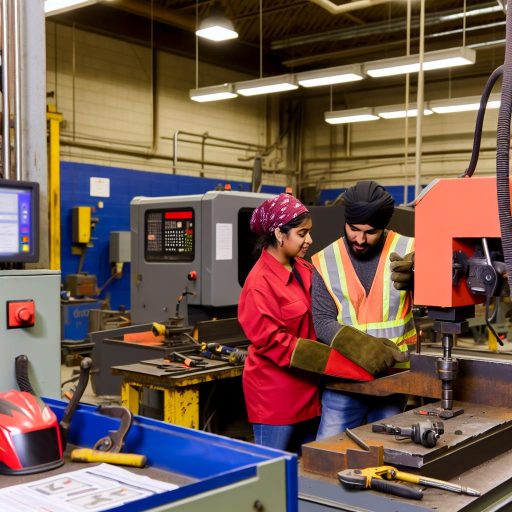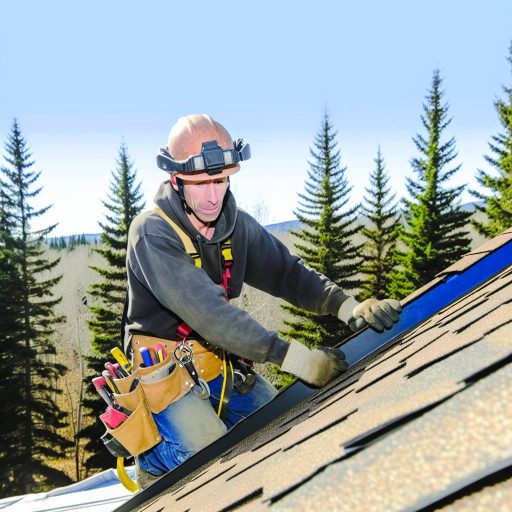Overview of Construction Laws Relevant to Bricklaying
Understanding Local Regulations
Every bricklayer must comply with local laws and regulations.
These rules dictate safety standards and operational procedures.
Local governments specify building codes for construction projects.
Additionally, obtaining the correct permits is crucial for legality.
Worker Safety Requirements
Safety is paramount in the construction industry.
Bricklayers must adhere to OSHA regulations to protect themselves.
Personal protective equipment (PPE) is mandatory on job sites.
This equipment includes hard hats, gloves, and safety glasses.
Licensing and Certifications
Many regions require bricklayers to hold a valid license.
This process often involves passing a practical exam.
Additionally, ongoing education helps maintain licenses.
Certifications can enhance a bricklayer’s credibility and skills.
Contractual Obligations
Bricklayers engage in various contracts with clients and contractors.
These contracts outline job scope, payment, and timelines.
Understanding contractual obligations is vital to prevent disputes.
Disputes may arise from misunderstandings or unmet clauses.
Environmental Regulations
Construction activities often impact the environment.
Bricklayers should be aware of local environmental laws.
These laws may regulate waste disposal and material use.
Compliance helps minimize ecological disruption from projects.
Insurance and Liability
Bricklayers must obtain suitable insurance coverage.
This protects against potential liabilities and workplace injuries.
Liability insurance is particularly important in construction.
It covers damages resulting from accidents on job sites.
Understanding Licensing and Certification Requirements for Bricklayers
Importance of Licensing
Licensing is vital for bricklayers across various regions.
Unlock Your Career Potential
Visualize a clear path to success with our tailored Career Consulting service. Personalized insights in just 1-3 days.
Get StartedIt ensures compliance with local and national regulations.
Furthermore, licensed bricklayers demonstrate professionalism.
Clients often prefer hiring licensed workers for their projects.
Typical Licensing Requirements
Specific requirements can vary by state or province.
Most regions require bricklayers to obtain a general contractor’s license.
Some areas may require additional certifications related to masonry work.
Additionally, passing a written examination is often necessary.
Certification Opportunities
Several organizations offer certifications in masonry skills.
The National Center for Construction Education and Research provides training programs.
Such certifications can enhance a bricklayer’s job prospects.
Moreover, these certifications validate specific skills and competencies.
Continuing Education Requirements
Many states mandate continuing education for license renewal.
Bricklayers must stay informed about evolving building codes.
Workshops and courses can help bricklayers maintain their licenses.
These educational opportunities often cover new technology and materials.
Steps to Obtain a License
The first step involves researching local licensing requirements.
Next, individuals should complete any required education or training.
Afterward, applicants need to gather necessary documentation.
Finally, they can submit their application and fees to the appropriate authority.
Key Safety Regulations Affecting Bricklaying Operations
Understanding Worksite Safety
Ensuring safety on job sites is a priority for bricklayers.
Proper training minimizes risks and improves overall safety.
Employers must provide personal protective equipment (PPE) to their workers.
This equipment includes gloves, helmets, and safety glasses.
Furthermore, regular safety audits help identify hazards promptly.
Regulations from Occupational Safety and Health Administration (OSHA)
OSHA sets clear guidelines for workplace safety in construction.
Bricklayers must adhere to OSHA regulations to prevent accidents.
For instance, scaffolding must meet specific safety standards.
Moreover, fall protection measures must be in place for elevated work.
Employers have the responsibility to educate workers about these regulations.
Environmental Compliance
Bricklaying operations must comply with local environmental laws.
Concrete and mortar dust can impact air quality significantly.
Using dust suppression techniques can mitigate these effects.
Additionally, proper waste disposal practices are essential.
Failure to follow these regulations may lead to legal consequences.
Handling Materials Safely
Bricklayers often handle heavy materials, which require care.
Proper lifting techniques can prevent injuries and strains.
Forklifts and hoists should be used for heavy lifting whenever possible.
Furthermore, materials should be stored securely to prevent accidents.
Regular inspections ensure that tools and equipment are safe to use.
Emergency Preparedness Plans
Every bricklaying business should have an emergency preparedness plan.
This plan should outline procedures for various emergencies.
Training workers on these procedures ensures quick response times.
Regular drills can help familiarize employees with emergency protocols.
Ultimately, preparedness can save lives and reduce injuries.
Delve into the Subject: Exploring the Day-to-Day Tasks of an Ironworker
The Role of Contracts in Bricklaying Projects
Importance of Clear Agreements
Contracts clearly define the expectations of all parties involved.
They help prevent misunderstandings between clients and bricklayers.
A well-drafted contract outlines project scope, timelines, and costs.
Additionally, it establishes a basis for conflict resolution.
Essential Elements of Bricklaying Contracts
A bricklaying contract should include specific details.
First, it must list the names and contact information of the parties.
Next, the contract should detail the project’s scope and specifications.
Furthermore, it needs to specify the payment schedule and amounts.
Finally, include terms related to dispute resolution and termination.
Legal Protections Offered by Contracts
Contracts provide legal protections for both clients and bricklayers.
They ensure that each party fulfills their obligations.
If a dispute arises, contracts can be legally enforceable documents.
Moreover, they may include clauses to mitigate risks.
Common Contractual Disputes
Disputes can occur for various reasons in bricklaying projects.
One common issue involves delays in project completion.
Another frequent dispute arises from disagreements over costs.
Therefore, it’s crucial to address these potential issues proactively.
Best Practices for Contract Management
Proper contract management is vital for successful bricklaying projects.
Regularly review contracts to ensure compliance with terms.
Communicate openly with all parties throughout the project.
Finally, keep accurate records of all modifications and agreements.
Gain More Insights: Key Tools Used by Professional Metal Fabricators
Liabilities and Insurance for Bricklayers
Understanding Liabilities
Bricklayers face various liabilities in their profession.
These liabilities can arise from accidents or damages occurring on the job.
It is essential to recognize both personal and professional liabilities.
Negligence is a critical factor affecting liability claims.
For example, improper installation of materials could lead to significant damages.
Additionally, third-party claims can impact a bricklayer’s financial standing.
Thus, understanding these liabilities is crucial for risk management.
Importance of Insurance
Insurance serves as a protective measure for bricklayers.
It helps cover potential liabilities and associated legal costs.
General liability insurance is a fundamental policy for professionals.
This insurance covers bodily injury and property damage claims.
Moreover, workers’ compensation insurance protects against employee injuries.
In some jurisdictions, this insurance is legally required.
Bricklayers should regularly review their insurance coverage.
This ensures they remain adequately protected against evolving risks.
Types of Relevant Insurance Policies
- General Liability Insurance
- Workers’ Compensation Insurance
- Professional Liability Insurance
- Commercial Auto Insurance
Each insurance type addresses specific risks associated with bricklaying.
General liability insurance offers coverage for on-site incidents.
Professional liability insurance protects against claims of negligence.
Commercial auto insurance covers vehicles used for work purposes.
Choosing the Right Insurance Policy
Selecting the appropriate insurance involves careful consideration.
Bricklayers should assess their unique risks and activities.
Consulting with an insurance agent can provide valuable insights.
It is wise to compare multiple insurance quotes before making a decision.
Familiarity with policy terms and conditions is crucial as well.
Bricklayers should ask questions and clarify any uncertainties.
Tailoring insurance coverage to specific business needs enhances protection.
Find Out More: Challenges and Rewards of Residential Roofing Jobs

Dispute Resolution Mechanisms in Construction Law
Overview of Dispute Resolution
Disputes frequently arise in the construction industry.
Bricklayers may encounter disagreements regarding project specifications.
Moreover, conflicts can emerge over payment terms and timelines.
Understanding dispute resolution mechanisms is crucial for bricklayers.
Litigation
Litigation is a common method for resolving disputes in construction.
It involves taking the disagreement to court for a legal resolution.
This process tends to be lengthy and expensive.
Bricklayers should consider this option as a last resort.
Litigation results in a binding judgment from a judge or jury.
Alternative Dispute Resolution (ADR)
Alternative dispute resolution offers more flexible options.
This includes methods like mediation and arbitration.
Mediation involves a neutral third party facilitating discussions.
Arbitration, on the other hand, involves a binding decision by an arbitrator.
These methods are often faster and less costly than litigation.
Mediation
Mediation encourages open communication between parties.
A mediator helps both sides explore potential solutions.
It allows for a collaborative approach to resolving issues.
Bricklayers can benefit from mediation’s informal process.
Arbitration
Arbitration is more formal than mediation but generally quicker than litigation.
The arbitrator reviews evidence and makes a binding decision.
This process reduces the time spent on disputes significantly.
Moreover, arbitration can be more private than court proceedings.
Negotiation
Negotiation is the simplest form of dispute resolution.
It involves direct discussions between the disputing parties.
Bricklayers can negotiate payment or project requirements directly.
While negotiation requires compromise, it fosters better relationships.
It may lead to mutually satisfactory outcomes in a timely manner.
Choosing a Dispute Resolution Method
Selecting the right dispute resolution mechanism is essential.
Factors include the nature of the dispute and time constraints.
Furthermore, parties should consider their relationship dynamics.
Effective communication often enhances the success of ADR methods.
Bricklayers should familiarize themselves with these options.
Legal Considerations
Understanding the legal framework surrounding dispute resolution is important.
Bricklayers should know their rights and responsibilities under construction law.
Moreover, staying informed about local regulations assists in dispute avoidance.
Consulting with legal experts can provide valuable insights.
See Related Content: How Upholsterers Collaborate with Designers and Architects
Local Building Codes and Their Impact on Bricklaying Practices
Understanding Local Building Codes
Local building codes establish the legal requirements for construction projects.
These codes ensure safety, health, and welfare in building practices.
They differ significantly from one locality to another.
Bricklayers must familiarize themselves with these codes.
This knowledge protects both the bricklayer and the client.
Your Legal Responsibilities as a Bricklayer
Compliance with local building codes is essential for bricklayers.
Failure to adhere can lead to legal repercussions.
Moreover, it can result in project delays or work stoppage.
Bricklayers must obtain necessary permits before starting work.
Staying informed about code changes is also crucial.
The Importance of Quality Materials
Building codes often specify the types of materials allowed.
Using substandard materials can lead to serious structural issues.
Bricklayers should always use materials that meet code requirements.
This not only ensures safety but also enhances durability.
Adhering to local codes can improve a builder’s reputation.
Inspections and Compliance
Many projects require inspections at various stages of construction.
Bricklayers should prepare for these inspections in advance.
Understanding what inspectors will look for can facilitate smoother evaluations.
Regularly reviewing the local codes can help meet inspection standards.
Knowledge of compliance can ultimately save time and resources.
Staying Updated on Changes
Local building codes can change frequently.
Bricklayers must stay updated on these changes to remain compliant.
Attending workshops and training can be beneficial.
Building relationships with local inspectors might also provide insights.
Online resources can help bricklayers access the latest information.
Collaboration with Other Professionals
Bricklayers often work alongside architects and engineers.
Open communication can enhance adherence to local building codes.
Understanding project specifics allows for better compliance.
Collaboration fosters a culture of safety and quality.
All parties benefit from adhering to building regulations.
Recent Legal Trends and Cases Affecting the Bricklaying Industry
Shifting Regulatory Landscapes
Governments are increasingly updating construction laws to enhance safety and efficiency.
Bricklayers must stay informed to comply with these changes.
As a result, awareness of local regulations has become essential.
In addition, changes in zoning laws can impact project feasibility.
Key Court Cases Impacting the Bricklaying Sector
A recent case in Springfield defined liability concerning construction defects.
The ruling clarified accountability between contractors and subcontractors.
This case sets a precedent for future litigation in the industry.
Moreover, another decision in Brooklyn highlighted the importance of contracts.
Judges emphasized the need for clear terms to avoid legal disputes.
Emerging Trends in Labor Laws
Labor laws are evolving, focusing on worker rights and safety standards.
Bricklayers now have more protections under recent legislation.
These protections include fair wages and safe working conditions.
Furthermore, regulations around overtime pay are becoming stricter.
Bricklayers should familiarize themselves with these new agreements.
Environmental Regulations Affecting Construction
Environmental compliance is increasingly critical for construction projects.
Bricklayers may face penalties for not adhering to these laws.
Legislation aims to reduce carbon footprints in the construction sector.
Additionally, building materials are now scrutinized for environmental impacts.
Understanding these regulations can enhance business credibility and sustainability.
The Role of Professional Associations
Professional associations are vital in advocating for bricklayers’ rights.
They provide valuable resources for understanding legal requirements.
These organizations often offer training programs focusing on compliance.
Furthermore, they can help members network with legal professionals.
Such connections can be beneficial in navigating complex legal landscapes.
Additional Resources
How many person-hours does it take to build a house? : r …
Building an Equitable Construction Workforce: Understanding and …




